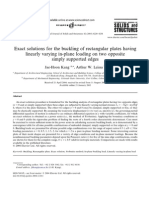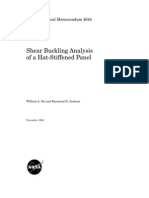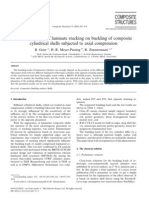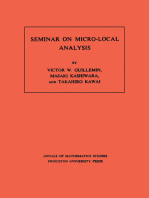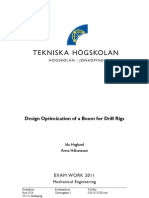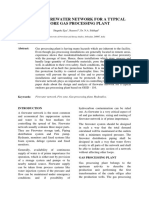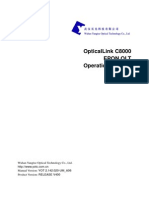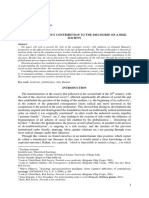Stability Analysis of Composite Panels With Stiffeners and Circular Cutouts
Stability Analysis of Composite Panels With Stiffeners and Circular Cutouts
Uploaded by
Saad Al HelyCopyright:
Available Formats
Stability Analysis of Composite Panels With Stiffeners and Circular Cutouts
Stability Analysis of Composite Panels With Stiffeners and Circular Cutouts
Uploaded by
Saad Al HelyOriginal Title
Copyright
Available Formats
Share this document
Did you find this document useful?
Is this content inappropriate?
Copyright:
Available Formats
Stability Analysis of Composite Panels With Stiffeners and Circular Cutouts
Stability Analysis of Composite Panels With Stiffeners and Circular Cutouts
Uploaded by
Saad Al HelyCopyright:
Available Formats
Jordan Journal of Civil Engineering, Volume 4, No.
2, 2010
Stability Analysis of Composite Panels with Stiffeners and Circular Cutouts
Husam Al-Qablan 1)�, Hazim Dwairi 1), Nasim Shatarat 1), Taleb Rosan 1) and Tamara Al-Qablan 2)
Department of Civil Engineering, Hashemite University, 13115 Zarqa, Jordan Corresponding author. Tel: +962 (5) 3903333 EXT 4708; Fax: +962 (5) 3826613 E-mail address: hqablan@hotmail.com 2) Department of Information Technology, Al-Huson University College, Al-Balqa Applied University, 50 Al-Huson, Jordan
�
1)
ABSTRACT
Buckling of simply supported square orthotropic plates with multi-blade stiffeners is addressed herein. An approximate, semi-analytical model for such plates subjected to in-plane loading is derived. The optimal buckling load of simply supported laminated composite blade-stiffened panels with circular cutouts is predicted using Finite Element Analysis. In this optimization, the design variables were the cutout size, cutout location, fiber orientation angles, number and locations of stiffeners. Three types of in-plane loading were considered; namely, uniaxial, biaxial and shear loading. Based on the model studies, the total increase in the buckling load due to the presence of cutouts and stiffeners can reach up to 5 times in uniaxial loading, 7 times in biaxial loading and 2 times in shear loading compared to perfect plates. Several other imperative findings are identified based upon the various parameters influencing the buckling behavior. Guidelines for the optimal stiffeners' configurations and cutouts' proportioning are developed. KEYWORDS: Buckling, Stiffened panels, Cutouts, FE analysis, Composite structures.
INTRODUCTION Linear plate buckling is an important issue in designing many structural systems, particularly when minimum weight is a primary design objective. Cutouts in composite laminated panels are often found for accessibility reasons or to just lighten the structure. In aircraft wings, for example, cutouts are needed for fuel lines, electric lines or to reduce the overall weight of the wing. The presence of these cutouts complicates the stress distribution in the composite panels. The effects of cutouts in laminated plates subjected to different work load conditions on the buckling loads have been investigated by many researchers over the past years
Accepted for Publication on 15/4/2010.
(Ghannadpour et al., 2006; Jain and Kumar, 2004; Anil et al., 2007; Kong et al., 2001; Larsson, 1987). They concluded that buckling load decreases as the central circular/elliptical/square hole dimensions increase. Stiffeners have been widely used in the composite laminated panels to overcome the reduction in the buckling load due to the presence of cutouts in the composite laminated panels. A great deal of attention has been focused on plates reinforced by stiffeners to improve their buckling behavior. Many researchers used numerical methods like FEM to clearly understand the buckling behavior of composite panels (Kolakowski and Kubiak, 2005; Kim, 1996). Kang and Kim (2005), Perry et al. (1997) and Bisagni and Lanzi (2002) studied the buckling and postbuckling behavior of composite stiffened panels subjected to compressively axial loads. In their studies, optimization techniques were applied to
- 119 -
2010 JUST. All Rights Reserved.
Stability Analysis
Husam Al-Qablan, Hazim Dwairi, Nasim Shatarat, Taleb Rosan and Tamara Al-Qablan
nonlinear finite element analysis codes. The optimization aimed at minimizing the weight of stiffened composite structures under load constrains in the postbuckling region. Analysis of laminated composite stiffened panels is complex. Many researchers have tried to develop some guidelines and curves, which would be helpful for the designers (Nemeth, 1997; Pecce and Cosenza, 2000; Iyengar and Chakraborty, 2004). Alinia (2005) studied the buckling behavior of stiffened plates subjected to shear loads. In his study, over 1200 plates were analyzed to study the role stiffened and to come up with some limits for an optimization design procedure. Mallela and Upadhyay (2006) presented some parametric studies on simply supported laminated composite blade-stiffened panels subjected to shear loads. They concluded that panels with high orthotropy ratio and less pitch length (more number of stiffeners with less depth) are preferable for shear buckling point of view. This study is mainly concerned with the buckling behavior of simply supported orthotropic and laminated composite blade-stiffened panels with circular cutouts subjected to three types of loading; uniaxial, biaxial and shear loading. The weights for all composite laminated plates were kept constant to achieve the optimal buckling load. The effects of the circular cutouts and the blade-stiffeners on the buckling behavior of laminated composite plates were taken into consideration. Based on the analysis, few important parameters influencing the buckling behavior are identified and guidelines for better stiffeners and cutouts' proportioning are
developed, which will be helpful for the designers. BASIC EQUATIONS AND PROBLEM FORMULATION The elastic buckling load of a perfect square orthotropic stiffened panel is computed using RayleighRitz method. The assumed displacement field, which satisfies the boundary condition of a simply supported plate, is given by the form of Fourier series:
w=
q
m =1 n =1
mn
m x n y sin sin a b
2w @ x = 0; x = a : w = 0, M x = 0 or x 2 = 0 2 w @ y = 0; y = b : w = 0, M y = 0 or y 2 = 0
(1)
where the unknown coefficients q mn represent generalized displacement amplitudes, the constants a and b are the plate length and width, respectively. The first eigenvalue (the lowest critical load) for square stiffened orthotropic plates would occur for m = n = 1 ; therefore the assumed displacement field will reduces to: x y w = q11 sin (2) sin a b According to the principle of conservation of energy, the potential energy of the orthotropic plate is defined as = U 1 + W1 , where U 1 is the strain energy and W1 is the potential energy of the external loads and can be written in the forms below.
U1 =
1 2
(D ( w)
b a 11 x, x 0 0
+ 2 D12 x , x w y , y w + D 22 y , y w 2 + 4 D s x , y w
)dxdy
(3)
1 W1 = 2
(N
0 0
b a
( x w) 2 + N y ( y w) 2 + N xy ( x w y w)) dxdy
(4)
where, the subscripts preceded by a comma denote
2 partial derivatives (e.g., x , x w = w
y 2
), N x , N y
and N xy are the internal forces acting in the middle surface of the plate due to the applied in-plane loading, D11 , D22 , D12 and Ds are the flexural and torsional
- 120 -
Jordan Journal of Civil Engineering, Volume 4, No. 2, 2010
rigidities of an orthotropic plate, respectively, and are given as: E2 h 3 E1 h 3 D11 = ; D 22 = ; 1 1 2 12 1 1 2 12
D12 =
E1 2 h 3 E Gh 3 ; Ds = ; 2 = 1 2 1 1 2 12 E1 12
Herein, E1 , E 2 , 1 , 2 and G are assumed to be elastic constants of an orthotropic material, i.e., E1 , E 2 ; and 1 , 2 are the moduli of elasticity and Poissons ratios in the x and y directions, respectively. G is the shear modulus and h is the plate thickness. For biaxial case, the load in the y direction N y can be simplified as a function of the load in the x direction N y = N x , where is a constant (0 1) . The first variation of the potential energy yields the equilibrium state, and by setting the variation in the total potential energy equal to zero q11 = 0 , the critical buckling load for orthotropic plate subjected to uniaxial or biaxial loads can be expressed as follows.
Nx = h 3 2 (4G ( 1 2 1) (1 + 2 2 )E1 E 2 )
12b 2 ( 1 2 1)(1 + )
where j and k represent the number of stiffeners parallel to the x and y direction, respectively, and d i and ci are the location of the stiffeners in the x and y direction, respectively. The potential energy for the orthotropic panels with blade isotropic stiffeners can be expressed as follows: = U 1 + U 2 + U 3 + W1 + W 2 + W3 (7) where U 1 , U 2 and U 3 represent the strain energy of the orthotropic plate, stiffeners in the x direction and stiffeners in the y direction, respectively, while W1 , W2 and W3 represent the potential energy of the external loads for the orthotropic plate, stiffeners in the x direction and stiffeners in the y direction, respectively. Herein, U 1 and W1 are shown in equations 3 and 4, respectively, while U 2 , W 2 , U 3 and W3 can be expressed as follows:
U2 =
i =1 j
EI xi 2
(
0
x, x
w sx ) 2 d x
(8)
W2 =
i =1 k
(5)
U3 =
N x Axi 2h EI yi 2
2 ( x wsx ) d x 0
(9)
(10)
For the case of orthotropic panels with blade isotropic stiffeners, two modes of buckling are usually considered; the local buckling of the plate between the stiffeners and the overall buckling (primary buckling) of the plate-stiffener combination. Herein, the derivation of buckling load is concerned with the primary buckling. The assumed displacement field for the stiffeners is given by the form of Fourier series:
w sx = w sy =
i =1 k
(
0
y, y
w sy
d y
W3 =
i =1
N y A yi 2h
(
0
w sy
d y
(11)
q
i =1 k
11
x ci sin sin a b
i =1
di q11 sin a
y sin b
(6)
Substituting equations 3, 4, 8, 9, 10 and 11 into equation 7 and differentiating with respect to the coefficient q11 and by setting the variation in the total potential energy equal to zero q11 = 0 , the critical buckling load for orthotropic plate with multi-blade isotropic stiffeners subjected to uniaxial or biaxial loads can be expressed as follows:
h 3 ((1 + 2 )E1 + (1 + 1 )E2 ) + ( 1 2 1) 2 2 2 j j k k c D 3 i i 4 Gh + 6 D sin i + i sin b b i =1 i =1 i =1 i =1 Nx = 2 2 j j k k c D 12b 2 1 + + 2 sin i i + 2 sin i i i =1 b i =1 i =1 b i =1
(12)
- 121 -
Stability Analysis
Husam Al-Qablan, Hazim Dwairi, Nasim Shatarat, Taleb Rosan and Tamara Al-Qablan
where
i =
A yi EI yi A EI xi ; i = ; i = xi ; i = Db bh bh Db
D=
E h3 1 2 12
represents the stiffness of the
Poisson's ration of the stiffeners, respectively. I xi and I yi represent the moment of inertia of stiffeners parallel to the x and y direction, respectively. Axi and A yi represent the cross-sectional area of stiffeners parallel to the x and y direction, respectively. For isotropic stiffened plates, equation (12) reduces to:
stiffeners. E and are the modulus of elasticity and
2 2 j j k k D ci i + 2 D 2 + sin sin i i b b i =1 i =1 i =1 i =1 Nx = 2 2 j j k k c i Di 2 + + + b 1 2 sin 2 sin i i b b i =1 i =1 i =1 i =1 2
(13)
Table (1): Material properties of the lamina Mechanical Properties Values 130.0 GPa E1 10.0 GPa E2
E3 G12 = G13
10.0 GPa 5.0 GPa 0.35 0.35
12 = 13 23 = 32
(a)
(b)
Figure (1): Orthotropic blade-stiffened panel (a) before buckling (b) after buckling
- 122 -
Jordan Journal of Civil Engineering, Volume 4, No. 2, 2010
160
Equation 12
120 80 40 0
(a)
80 Equation 12 FEM 40
(b)
FEM
0
0 1 2 3 4 5
hs / h
hs / h
Figure (2): Nondimensional buckling load for orthotropic blade-stiffened panels subjected to (a) uniaxial loads (b) biaxial loads
0.25 b
0.5 b
0.25 b
0.5 b 0.25 b
0.5 b 0.25 b
0.5 b 0.5 b 0.5 b 0.25 b
0.5 b 0.5 b 0.5 b 0.25 b
0.5 b
0.5 b
0.25 b
0.5 b
0.25 b
Stiffeners
(a)
Cutouts
(b)
0.5 b
0.5 b
0.25 b 0.5 b
0.5 b 0.5 b 0.25 b
0.25 b
0.5 b
0.25 b
(c)
Figure (3): Undeformed shape for the laminated composite blade-stiffened panels with circular cutouts (a) case 1 (b) case 2 (c) case 3 VALIDATION The present model described in the previous section was incorporated into a MATHEMATICA software, and computed results have been compared with finite element analysis using ABAQUS software for a variety of plates and stiffener dimensions. Herein, results are limited to orthotropic panels with isotropic stiffeners.
The plate dimension is 1000 mm x 1000 mm. The thickness of the plate and the stiffeners is t = 12mm . The material properties of the orthotropic plate are given in Table 1. The adopted elastic material properties for the isotropic stiffeners in each computation are Young's modulus E = 130 GPa and Poisson's ratio = 0.35 . In this comparison, two equally spaced
- 123 -
Stability Analysis
Husam Al-Qablan, Hazim Dwairi, Nasim Shatarat, Taleb Rosan and Tamara Al-Qablan
stiffeners in each direction with different heights hs were used to compute the critical loads for the uniaxial and biaxial cases as shown in Figure 1. The finite element model is composed of mainly four noded quadrilaterals, stress/displacement shell element with reduced integration and large-strain formulation
(ABAQUS manual). Each node has six degrees of freedom. The orthotropic stiffened panels are divided into a sufficient number of elements to allow for free development of buckling modes and displacements. Some trial runs are also carried out to study the convergence of the results.
Figure (4): Loading system (a) uniaxial loading (b) biaxial loading (c) shear loading
The results of uniaxial and biaxial load cases are compared to finite element results as shown in Figure 2. From these results, it can be observed that the present model and finite element results are in good agreement. It is worth mentioning that the comparison between theoretical and numerical values shown in Figure 2 reveals some notable discrepancies, mainly with the deeper stiffeners. This is mainly due to the effect of the torsional stiffness and shear deformation accounted for in the finite element model, but not in the present model. This explains most of the marginal differences between these two curves.
MODELING COMPOSITE LAMINATED STIFFENED PANELS WITH STIFFENERS AND CIRCULAR CUTOUTS Modeling composite laminated stiffened panels
needs extra attention in defining the properties of the plates, stiffeners, number of layers and fibers orientation angles of each layer. In the present work, Eigenbuckling analysis is performed for the laminated composite blade-stiffened panels using a finite element package ABAQUS. The plate dimension is also 1000 mm x 1000 mm. The thickness of each layer of this eight-layer laminates is 1.5 mm. The properties of the material of the lamina are given in Table 1. The model is composed of mainly four noded quadrilaterals, stress/displacement shell element with reduced integration and large-strain formulation. Three noded shell elements are only used in irregular zones around the holes as shown in Figure 3. In this study, three different cases of simply supported square plates with circular cutouts and stiffeners were studied; case 1: one hole at the center of
- 124 -
Jordan Journal of Civil Engineering, Volume 4, No. 2, 2010
the laminate with two stiffeners in each direction located at 0.25% and 0.75% of edge length, case 2: two holes with two stiffeners parallel to the x direction located at 25% and 0.75% of edge length and one stiffener parallel to the y direction located at 0.5% of the plate edge, case 3: four holes with one stiffener in each direction located at 0.5% of the plate edges. The locations of the holes and stiffeners for the three cases are shown in Figure 3. The plate area is located in the xy plan. For uniaxial loading, the compressive loads were applied in the x direction, while for biaxial and shear loadings, the loads were applied in the x and y directions as shown in Figure 4. Series of pre-selected
cases are modeled to verify the accuracy of the method of analysis. The results are compared to theoretical and numerical values available in the literature. Table (2) shows a comparison between the current study and theoretical results for isotropic panels without stiffeners subjected to uniaxial, biaxial and shear loads, while Table (3) shows a comparison between the current study and results available in the literature for composite laminated plate [0,90]2s with circular cutout subjected to uniaxial loads. From these results, it can be observed that the present study and the values available in the literature are in good agreement.
Figure (5): First buckling mode shape for (a) uniaxial loading (b) biaxial loading (c) shear loading
The buckling mode shapes obtained in the present study are similar in respect with the buckling mode shapes available in the literature as shown in Figure 5. In the present study, the weights for all panels were kept constant through utilizing the areas removed by circular cutouts in constructing the stiffeners. The stacking sequences, numbers and thicknesses of layers of the stiffeners are identical to that of the laminated panels. The length of each stiffener is equal to the edge length of the plate (1000 mm). The edges of the stiffeners are not penetrating the plates as shown in Figure 3. The
depths of each stiffener in the three cases are shown in Table 4.
EFFECT OF CUTOUT SIZE, LOCATION AND NUMBER OF STIFFENERS ON THE BUCKLING LOADS In order to achieve the optimal cutout size and location, optimal fiber orientation angles and optimal number of stiffeners, the laminated panels were subjected to uniaxial, biaxial and shear loads. The ratio of the cutout diameter (d) to the plate width (b) for
- 125 -
Stability Analysis
Husam Al-Qablan, Hazim Dwairi, Nasim Shatarat, Taleb Rosan and Tamara Al-Qablan
plates with one hole (case 1) is varied from 0.0 to 0.8. The removed areas for plates with one hole (case 1) were divided by 2 and 4 to calculate the new areas for cutouts in plates with two holes (case 2) and plates with
four holes (case 3), respectively. These removed areas were used to construct the stiffeners in the three cases as shown in Figure 3 and Table (4).
Table (2): Comparison of results between theoretical and numerical methods for isotropic panels without stiffeners nondimensional nondimensional buckling load buckling load Percentage Isotropic b (Exact) (Numerical) E (Pa) h (m) difference Material (m) N cr b 2 N cr b 2 Eh 3 Eh 3 0.0005 3.61524 3.6176 0.065 0.0010 3.61524 3.6170 0.057 Uniaxial Case 0.0050 3.61524 3.6096 0.157 4 2 D 1.0 2 1011 0.3 N cr = 0.0100 3.61524 3.59225 0.636 b2 0.0200 3.61524 3.55234 1.739 0.0300 3.61524 3.51024 2.904 0.0005 1.80762 1.8088 0.065 0.0010 1.80762 1.80865 0.057 Biaxial Case 0.0050 1.80762 1.80476 0.158 2 2 D 1.0 2 1011 0.3 N cr = 0.0100 1.80762 1.79613 0.636 b2 0.0200 1.80762 1.77617 1.739 0.0300 1.80762 1.75513 2.903 0.0005 8.44158 8.4504 0.100 0.0010 8.44158 8.4500 0.100 Shear Case 0.0050 8.44158 8.4328 0.104 9.34 2 D 1.0 2 1011 0.3 N cr = 0.0100 8.44158 8.3920 0.587 b2 0.0200 8.44158 8.2835 1.870 0.0300 8.44158 8.1499 3.450 Table (3): Comparison of results between current study and results available in the literature for composite plate [0,90]2s with circular cutout subjected to uniaxial loads nondimensional buckling load nondimensional buckling load (Numerical) (Ghannadpour et al.) N cr b 2 2 d/b N cr b E h3
0.0 0.1 0.2 0.3 0.4 0.5 0.6 0.8
E2 h 3 13.79 12.80 10.82 8.97 7.51 6.39 5.63 4.43
13.60 13.07 10.53 8.80 7.42 6.40 5.31 4.37
- 126 -
Jordan Journal of Civil Engineering, Volume 4, No. 2, 2010
d/b 0.1 0.2 0.3 0.4 0.5 0.6 0.7 0.8
Table (4): Circular cutouts' and stiffeners' dimensions Area removed by depth of each stiffener cutouts/total area of the plate case 1 case 2 case 3 0.00785398 0.0019635 0.00261799 0.0039270 0.0314159 0.0078540 0.0104720 0.0157080 0.0706858 0.0176715 0.0235619 0.0353429 0.125664 0.0314159 0.0418879 0.0628319 0.196350 0.0490874 0.0654498 0.0981748 0.282743 0.0706858 0.0942478 0.141372 0.384845 0.0962112 0.1282817 0.192423 0.502655 0.1256638 0.1675517 0.251327
90
90
N xb2 E2h2
60
Two Holes Four Holes
N xb2 E2h2
One Hole
[0,90]2s
60
One Hole Two Holes Four Holes
[30,-30]2s
30
30
0 0 0.2 0.4 0.6 0.8
0 0 0.2 0.4 0.6 0.8
d/b
d/b
90
N xb2 E2h2
60
Four Holes
N xb2 E2h2
One Hole Two Holes
[45,-45]2s
90 One Hole Two Holes Four Holes
[45,-45,90,0,0,90,-45,45]
60
30
30
0 0 0.2 0.4 0.6 0.8
d/b
0.2
0.4
0.6
0.8
d/b
Figure (6): Nondimensional buckling load for laminated composite blade-stiffened panels with circular cutouts subjected to uniaxial loads
- 127 -
Stability Analysis
Husam Al-Qablan, Hazim Dwairi, Nasim Shatarat, Taleb Rosan and Tamara Al-Qablan
N xb2 E2h2
60
N xb2 E2h2
One Hole Two Holes Four Holes
[0,90]2s
[30,-30]2s
60 One Hole Two Holes Four Holes 30
30
0 0 0.2 0.4 0.6 0.8
0 0 0.2 0.4 0.6 0.8
d/b
d/b
N xb2 E2h2
60
[45,-45]2s
30
N xb2 E2h2
One Hole Two Holes Four Holes
60
One Hole Two Holes Four Holes
30
[45,-45,90,0,0,90,-45,45]
0 0 0.2 0.4 0.6 0.8 0 0 0.2 0.4 0.6 0.8
d/b
d/b
Figure (7): Nondimensional buckling load for laminated composite blade-stiffened panels with circular cutouts subjected to biaxial loads
- 128 -
Jordan Journal of Civil Engineering, Volume 4, No. 2, 2010
90
90 One Hole Two Holes Four Holes
N xb2 E2h2
N xb2 E2h2
[0,90]2s
One Hole Two Holes Four Holes
[30,-30]2s
60
60
30
30
0 0 0.2 0.4 0.6 0.8
0 0 0.2 0.4 0.6 0.8
d/b
d/b
90
90
[45,-45,90,0,0,90,-45,45]
One Hole Two Holes Four Holes
N xb2 E2h2
[45,-45]2s
N xb2 E2h2
One Hole Two Holes Four Holes
60
60
30
30
0 0 0.2 0.4 0.6 0.8
0 0 0.2 0.4 0.6 0.8
d/b
d/b
Figure (8): Nondimensional buckling load for laminated composite blade-stiffened panels with circular cutouts subjected to shear loads
It is well known that cutouts in laminated plates reduce the buckling loads (Ghannadpour et al., 2006). Also, it is well known that stiffeners in laminated plates increase the buckling loads (Mallela and Upadhyay, 2006). Herein, the interactions between the cutouts and stiffeners in laminated plates were studied to achieve the optimal buckling loads for plates having the same thicknesses and weights. For uniaxial and biaxial loading cases, Figures 6 and 7 show that the interactions between cutouts and stiffeners when changing the (d/b) ratio from 0.0 to 0.3 do not have any considerable effect
on the buckling loads compared to the perfect plate. For the (d/b) ratio from 0.4 to 0.6, it can be clearly seen from the Figures that the effect of stiffeners dominates the effect of cutouts and the total buckling load increases. The total increase in the buckling load can reach up to 5 times in uniaxial case and 7 times in biaxial case compared to the perfect plate. For the (d/b) ratio from 0.7 to 0.8, the buckling loads decrease and the effect of cutouts dominates the effect of stiffeners. The reason for this diminution in the buckling load is due to the reduction in the rigidity of the plate. The
- 129 -
Stability Analysis
Husam Al-Qablan, Hazim Dwairi, Nasim Shatarat, Taleb Rosan and Tamara Al-Qablan
spaces left between the cutouts became smaller and the stiffeners became larger. For these reasons, two types of buckling failure could occur; local buckling in the plate
reign (anti-symmetric mode) or local buckling in the stiffeners.
[0,90]2s
120
[30,-30]2s [45,-45]2s
90
[0,90]2s [30,-30]2s [45,-4]2s [45,-45,90,0,0,90,-45,45]
N xb2 E2h2
90
[45,-45,90,0,0,90,-45,45]
N xb2 E2h2
0 0.2 0.4 0.6 0.8
60
60
30
30
0 0 0.2 0.4 0.6 0.8
d/b
d/b
[0,90]2s
90
[30,-30]2s [45,-45]2s [45,-45,90,0,0,90,-45,45]
N xb2 E 2h2
60
30
0 0 0.2 0.4 0.6 0.8
d/b
Figure (9): Nondimensional buckling load for laminated composite blade-stiffened panels with circular cutouts subjected to (a) uniaxial loading (b) biaxial loading (c) shear loading
For the shear loading case, it can be seen from Figure 8 that the plates are more sensitive to the cutout size. For (d/b) ratio from 0.0 to 0.3, the buckling load decreases and the effect of cutouts dominates the effect of stiffeners, while for (d/b) ratio from 0.4 to 0.6 the total buckling loads start to increase and the effect of stiffeners dominates the effect of cutouts. For (d/b) ratio from 0.7 to 0.8, the buckling loads decrease and the effect of cutouts dominates the effect of stiffeners. The total increase in the buckling load for the shear loading case can reach up to 2 times compared to the perfect plate. The effect of fiber orientations on the buckling loads depends mainly on the cutout size, location and number of stiffeners as shown in Figures (6 - 8), the largest effect appears for (d/b) ratio from 0.4 to 0.6. Figure 9
shows the effect of fiber orientations on the buckling loads for case 3 (four holes with one stiffener in each direction) subjected to uniaxial, biaxial and shear loading. It can be clearly seen from the figure that the best performance was achieved using [45,-45, 90, 0, 0, 90,-45, 45] fiber orientations in the three loading cases. The optimal buckling load of simply supported square laminated composite blade-stiffened panels with circular cutouts for the three cases was found for (d/b) ratio from 0.4 to 0.6. It is worth mentioning that if the percentage of cutouts (d/b) exceeds the optimal limit, the total buckling load will decrease and the effect of cutouts will dominate the effect of stiffeners. This optimum limit depends on a lot of factors such as fiber orientation, type of loading, number and location of cutouts and stiffeners.
- 130 -
Jordan Journal of Civil Engineering, Volume 4, No. 2, 2010
CONCLUSION In the present work, the buckling behavior of square simply supported orthotropic plates with multi-blade stiffeners and laminated composite blade-stiffened panels with circular cutouts subjected to in-plane loading was investigated. The following conclusions can be drawn: An approximate, semi-analytical model for buckling of simply supported square orthotropic plates with multi-blade stiffeners subjected to inplane loading is derived. The optimal buckling load of simply supported square laminated composite blade-stiffened panels with circular cutouts subjected to three types of loading; namely, uniaxial compression, biaxial REFERENCES
Alinia, M. 2005. A study into optimization of stiffeners in plates subjected to shear loading, Thin-Walled Struct., 43: 815-845. Anil, V., Upadhyay, C.S. and Iyengar, N.G.R. 2007. Stability analysis of composite laminate with and without rectangular cutout under biaxial loading, Composite Structures, 80: 92-104. Bisagni, C. and Lanzi, L. 2002. Postbuckling optimization of composite stiffened panels using networks, Composite Structures, 58: 237-247. Ghannadpour, S.A.M., Najafi, A. and Mohammadi, B. 2006. On the buckling behavior of cross-ply laminated plates due to circular/elliptical cutouts, Composite Structures, 75: 3-6. HKS ABAQUS Users Manual: Theoretical Manual, ABAQUS Post Manual and Example Problem, Version 6.5. Iyengar, N.G.R. and Chakraborty, A. 2004. Study of interaction curves for composite laminate subjected to in-plane uniaxial and shear loading, Composite Structures, 64: 307-315. Jain, P. and Kumar, A. 2004. Postbuckling response of square laminates with a central circular/elliptical cutout, Composite Structures, 65: 179-185. Kang, J. and Kim, C. 2005. Minimum- weight design of compressively loaded composite plates and stiffeners
compression and shear loading was found for (d/b) ratio from 0.4 to 0.6. The total increase in the buckling load due to cutouts and stiffeners in the laminated composite panel can reach up to 5 times in uniaxial loading, 7 times in biaxial loading and 2 times in shear loading compared to the perfect plate. For uniaxial and biaxial load conditions, the effect of small cutouts and stiffeners (d/b ratio from 0.0 to 0.3) can be neglected. The buckling load is highly influenced by fiber orientation angles. The best performance was achieved using [45,-45, 90, 0, 0, 90,-45, 45] fiber orientations in the three loading cases.
panels for postbuckling strength by genetic algorithm, Composite Structures, 69: 239-246. Kim, K.D. 1996. Buckling behavior of composite panels using the finite elements method, Composite Structures, 36: 33-43. Kolakowski, Z. and Kubiak, T. 2005. Load-carrying capacity of thin load-walled composite structures, Composite Structures, 67: 417-426. Kong, C.W., Hong, C.S. and Kim, C.G. 2001. Postbuckling strength of composite plate with a hole, Reinforced Plastics Compos., 20: 466-481. Larsson, P. 1987. On buckling of orthotropic compressed plates with circular holes, Composite Structures, 7: 102121. Mallela, U. and Upadhyay, A. 2006. Buckling of laminated composite stiffened panels subjected to in-plane shear: a parametric study, Thin-Walled Structures, 44: 354-361. Nemeth, M.P. 1997. Buckling behavior of long symmetrically laminated plates subjected to shear and linearly varying axial edge loads, TP 3659: NASA. Pecce, M. and Cosenza, E. 2000. Local buckling curves for the design of FRR profiles, Thin Wall Structures, 37: 207-227. Perry, C.A., Gurdal, Z. and Starnes, J.H. 1997. Minimum weight design of compressively loaded stiffened panels for postbuckling response, Engineering Optimization, 28: 175-197.
- 131 -
You might also like
- Jsa Grinding Welding Gas CuttingDocument3 pagesJsa Grinding Welding Gas CuttingRana Waseem Khan83% (82)
- FInal Exam Oracle Academy Database DesignDocument16 pagesFInal Exam Oracle Academy Database DesignWildand Jw Ayegk Amsterdam100% (1)
- Control CableDocument2 pagesControl CableMuhammed FazilNo ratings yet
- Mechanics of Composite BeamsDocument21 pagesMechanics of Composite BeamskhazarhayatNo ratings yet
- Raft FoundationDocument9 pagesRaft FoundationSantosh KumarNo ratings yet
- Static Analysis of Circular Cylindrical Shell Under Hydrostatic and Ring ForcesDocument10 pagesStatic Analysis of Circular Cylindrical Shell Under Hydrostatic and Ring ForcestevredeNo ratings yet
- Buckling of Stiffened PlateDocument11 pagesBuckling of Stiffened PlatePugazhenthi ThananjayanNo ratings yet
- Analytical and Experimental Study of Vibration Behavior of FRP Composite I-BeamsDocument8 pagesAnalytical and Experimental Study of Vibration Behavior of FRP Composite I-BeamsRaviyashuNo ratings yet
- Effect of Winkler Foundation On Frequencies and Mode Shapes of Rectangular Plates Under Varying In-Plane Stresses by DQMDocument17 pagesEffect of Winkler Foundation On Frequencies and Mode Shapes of Rectangular Plates Under Varying In-Plane Stresses by DQMSalam FaithNo ratings yet
- 1.054/1.541 Mechanics and Design of Concrete Structures (3-0-9) Outline 11 Yield Line Theory For SlabsDocument9 pages1.054/1.541 Mechanics and Design of Concrete Structures (3-0-9) Outline 11 Yield Line Theory For SlabsSuNarto WAngNo ratings yet
- Theories and Analyses of Thin and Moderately Thick Laminated Composite Curved BeamsDocument14 pagesTheories and Analyses of Thin and Moderately Thick Laminated Composite Curved BeamsTejas GotkhindiNo ratings yet
- Finite Element Analysis and Reliability Assessment of Spherical LPG ...Document6 pagesFinite Element Analysis and Reliability Assessment of Spherical LPG ...Suleyman HaliciogluNo ratings yet
- Effect of The Boundary Conditions On In-Plane Dynamic Behavior of A Rectangular PlateDocument9 pagesEffect of The Boundary Conditions On In-Plane Dynamic Behavior of A Rectangular PlatebashmalNo ratings yet
- Frequency Optimization For Laminated Composite Plates Using Extended Layerwise ApproachDocument8 pagesFrequency Optimization For Laminated Composite Plates Using Extended Layerwise ApproachDEEPAKNo ratings yet
- ICME09-AM-07: Shubhankar Bhowmick, Dipten Misra and Kashi Nath SahaDocument6 pagesICME09-AM-07: Shubhankar Bhowmick, Dipten Misra and Kashi Nath SahaStoic FuadNo ratings yet
- Archive of SID: Stress Concentrations of Symmetrically Laminated Composite Plates Containing Circular HolesDocument14 pagesArchive of SID: Stress Concentrations of Symmetrically Laminated Composite Plates Containing Circular HolesAugusto Tinoco PadauiNo ratings yet
- Non-Linear Vibration of Cantilever Skew Plates Subjected To Aerodynamic and In-Plane Exciting ForcesDocument14 pagesNon-Linear Vibration of Cantilever Skew Plates Subjected To Aerodynamic and In-Plane Exciting ForcesMOFEEZALAMNo ratings yet
- Buckling of Imperfect Thick CylindricalDocument12 pagesBuckling of Imperfect Thick CylindricalnapoleonmNo ratings yet
- Kobayashi 1989Document14 pagesKobayashi 1989kirankonde.tutorNo ratings yet
- Hutchinson Fracture Delamination of Beams Under Transverse Shear and BendingDocument10 pagesHutchinson Fracture Delamination of Beams Under Transverse Shear and BendingTashi MalhotraNo ratings yet
- Exact Solutions For The Buckling of Rectangular Plates Having Linearly Varying In-Plane Loading On Two Opposite Simply Supported EdgesDocument19 pagesExact Solutions For The Buckling of Rectangular Plates Having Linearly Varying In-Plane Loading On Two Opposite Simply Supported EdgesskorabnNo ratings yet
- 08 Yang, NanaDocument8 pages08 Yang, NanaMouhat OuadiaNo ratings yet
- 53 391 PDFDocument16 pages53 391 PDFisraaahmed12No ratings yet
- Shen 1999Document20 pagesShen 1999Hasanain AlmusawiNo ratings yet
- Analysis of Straight and Skewed Box Girder Bridge by Finite Strip MethodDocument8 pagesAnalysis of Straight and Skewed Box Girder Bridge by Finite Strip MethodBharat SharmaNo ratings yet
- The Approximate Analytical Solution For The Buckling Loads of A Thin-Walled Box Column With Variable Cross-SectionDocument12 pagesThe Approximate Analytical Solution For The Buckling Loads of A Thin-Walled Box Column With Variable Cross-SectionRose VargasNo ratings yet
- Optimal Plastic Design of A Bar Under Combined Torsion, Bending and ShearDocument13 pagesOptimal Plastic Design of A Bar Under Combined Torsion, Bending and ShearKeerthi KumarNo ratings yet
- Analysis of Truss-Cable StructuresDocument9 pagesAnalysis of Truss-Cable StructuresKtk ZadNo ratings yet
- Analytical Approach of Springback of Arced Thin Plates BendingDocument6 pagesAnalytical Approach of Springback of Arced Thin Plates Bendingrudolf_laszlokNo ratings yet
- 1 s2.0 S0022460X97909925 MainDocument14 pages1 s2.0 S0022460X97909925 MainItalo RodriguesNo ratings yet
- Shear Buckling AnalysisDocument20 pagesShear Buckling AnalysisstarspleshNo ratings yet
- IJCER (WWW - Ijceronline.com) International Journal of Computational Engineering ResearchDocument8 pagesIJCER (WWW - Ijceronline.com) International Journal of Computational Engineering ResearchInternational Journal of computational Engineering research (IJCER)No ratings yet
- Young's Modulus, Shear Modulus, and Poisson's Ratio in Silicon and GermaniumDocument5 pagesYoung's Modulus, Shear Modulus, and Poisson's Ratio in Silicon and GermaniumMisti LucasNo ratings yet
- A Theoretical Solution of Cylindrical Shells For Axisymmetric Plain Strain Elastodynamic ProblemsDocument8 pagesA Theoretical Solution of Cylindrical Shells For Axisymmetric Plain Strain Elastodynamic ProblemsisraaNo ratings yet
- Damping Analysis of Laminated Plates and Beams Using RItz MethodDocument16 pagesDamping Analysis of Laminated Plates and Beams Using RItz MethodHimanshu DubeyNo ratings yet
- Flexural Analysis of Thick Beams Using Single Variable Shear Deformation TheoryDocument13 pagesFlexural Analysis of Thick Beams Using Single Variable Shear Deformation TheoryIAEME PublicationNo ratings yet
- Theories and Analyses of Thin and Moderately Thick Laminated Composite Curved BeamsDocument14 pagesTheories and Analyses of Thin and Moderately Thick Laminated Composite Curved BeamsFETNI MAAMARNo ratings yet
- MMF Angle PlyDocument6 pagesMMF Angle PlydoolyiiNo ratings yet
- 1988 Finite Element Analysis of Stability of Thin-Walled Beams of Open SectionDocument15 pages1988 Finite Element Analysis of Stability of Thin-Walled Beams of Open SectionHussein M. H. Al-KhafajiNo ratings yet
- CS 2006Document7 pagesCS 2006Dhana JayanNo ratings yet
- SegedinDocument14 pagesSegedinCiprian ComanNo ratings yet
- Analysis of Compression of Hollow Circular Elastomeric Bearings 1992Document9 pagesAnalysis of Compression of Hollow Circular Elastomeric Bearings 1992ciscoNo ratings yet
- Stiffened Plates PDFDocument16 pagesStiffened Plates PDFfarhadmrt6923No ratings yet
- Application of Differential Transform Method in Free Vibration Analysis of Rotating Non-Prismatic BeamsDocument8 pagesApplication of Differential Transform Method in Free Vibration Analysis of Rotating Non-Prismatic BeamsKhairul Anuar RahmanNo ratings yet
- Shell BucklingDocument17 pagesShell Bucklingisraaahmed12No ratings yet
- Plate Buckling NotesDocument0 pagesPlate Buckling NotesSharyn PolleyNo ratings yet
- Matriz de Rigidez GeometricaDocument14 pagesMatriz de Rigidez GeometricaManuel CruzNo ratings yet
- O-H. Kim, Y.C. Kim: 2. TheoryDocument4 pagesO-H. Kim, Y.C. Kim: 2. Theoryjainrakeshj4987No ratings yet
- Neutrally Reinforced Holes in Symmetrically Laminated PlatesDocument3 pagesNeutrally Reinforced Holes in Symmetrically Laminated Plateskhudhayer1970No ratings yet
- An Investigation Concerning Optimal Design of Solid Elastic PlatesDocument19 pagesAn Investigation Concerning Optimal Design of Solid Elastic Platescasoj29No ratings yet
- Corner Reinforcement in Reinforced Concrete Slabs: Mechanics, Importance, Estimation and UseDocument18 pagesCorner Reinforcement in Reinforced Concrete Slabs: Mechanics, Importance, Estimation and UseIbrahim KhanNo ratings yet
- DYNAMIC ANALYSIS OF LAMINATED CROSS-PLY PANEL UNDER LOCALIZED MOMENT by Ali Be IglooDocument6 pagesDYNAMIC ANALYSIS OF LAMINATED CROSS-PLY PANEL UNDER LOCALIZED MOMENT by Ali Be Iglooantony1993No ratings yet
- Finite Element by Tarun KantDocument7 pagesFinite Element by Tarun KantVijayraj11No ratings yet
- Cracked Continuous Rotors Vibrating On Nonlinear BearingsDocument10 pagesCracked Continuous Rotors Vibrating On Nonlinear BearingslucastcNo ratings yet
- Analysis of Tapered Beam Piezoelectric Energy HarvestersDocument4 pagesAnalysis of Tapered Beam Piezoelectric Energy HarvestersshikhamaharanaNo ratings yet
- Nonlinear Fracture Mechanics: John W. HutchinsonDocument54 pagesNonlinear Fracture Mechanics: John W. HutchinsonRamón GarciaNo ratings yet
- An Approximate Deflection Function For Simply Supported Quadrilateral Thin Plate by Variational ApproachDocument8 pagesAn Approximate Deflection Function For Simply Supported Quadrilateral Thin Plate by Variational ApproachDurukan Burak DilekNo ratings yet
- B. Geier (2002) On The Influence of Laminate Stacking On Buckling of Composite Cylindrical Shells Subjected To Axial CompressionDocument8 pagesB. Geier (2002) On The Influence of Laminate Stacking On Buckling of Composite Cylindrical Shells Subjected To Axial Compressionmc_ensNo ratings yet
- AnnaDocument99 pagesAnnaSaad Al HelyNo ratings yet
- Finite Element Analysis of Stresses Caused by External Holes in Hydraulic CylindersDocument11 pagesFinite Element Analysis of Stresses Caused by External Holes in Hydraulic CylindersSaad Al HelyNo ratings yet
- NimaDocument110 pagesNimaSaad Al HelyNo ratings yet
- Non Linear Analysis of Spur Gear Using Matlab CodeDocument105 pagesNon Linear Analysis of Spur Gear Using Matlab CodehazemismaeelradhiNo ratings yet
- Ali BadiDocument234 pagesAli BadiSaad Al HelyNo ratings yet
- Advance Steel 2015 Starting GuideDocument40 pagesAdvance Steel 2015 Starting Guidegranjero_mxNo ratings yet
- Illustrator Cs 5Document19 pagesIllustrator Cs 5Saad Al HelyNo ratings yet
- Corel Draw 2010Document33 pagesCorel Draw 2010Saad Al HelyNo ratings yet
- SimXpert2013 ThermalDocument230 pagesSimXpert2013 ThermalSaad Al HelyNo ratings yet
- Modeling and Visualization Analysis Reference: Abaqus/CAE User's Guide Abaqus Analysis User's GuideDocument1 pageModeling and Visualization Analysis Reference: Abaqus/CAE User's Guide Abaqus Analysis User's GuideSaad Al HelyNo ratings yet
- StructEngII Connections 276-327Document52 pagesStructEngII Connections 276-327Saad Al HelyNo ratings yet
- Structural Analysis of Micro Turbine by Using CFD Dr.R.Rajappan, K ChandrasekarDocument8 pagesStructural Analysis of Micro Turbine by Using CFD Dr.R.Rajappan, K ChandrasekarSaad Al HelyNo ratings yet
- Axisymmetric Analysis - A Problem in Which The Geometry, Loadings, Boundary Conditions and MaterialsDocument9 pagesAxisymmetric Analysis - A Problem in Which The Geometry, Loadings, Boundary Conditions and MaterialsSaad Al HelyNo ratings yet
- Propped Cantilever Mesh Convergence Study Using Hexahedral ElementsDocument10 pagesPropped Cantilever Mesh Convergence Study Using Hexahedral ElementsSaad Al HelyNo ratings yet
- Robust Design - EDRDocument8 pagesRobust Design - EDRSaad Al HelyNo ratings yet
- Mohammad SarairehDocument176 pagesMohammad SarairehamilcarsoaresNo ratings yet
- Implementations of SAP in BrazilDocument1 pageImplementations of SAP in BrazilNilesh KanjariyaNo ratings yet
- ASIC Layout - 2 Standard Cell Flow PDFDocument28 pagesASIC Layout - 2 Standard Cell Flow PDFEsakkiPonniahNo ratings yet
- Hydraulics AssignmentDocument35 pagesHydraulics AssignmentDamon LeongNo ratings yet
- 190-00356-00 400W Pilot Guide PDFDocument214 pages190-00356-00 400W Pilot Guide PDFLuis AndViNo ratings yet
- Desamito, Junella F. BSE 1-2 Exercise 2.3 EssayDocument3 pagesDesamito, Junella F. BSE 1-2 Exercise 2.3 EssayJunella DesamitoNo ratings yet
- Datasheet 12000 BtuDocument2 pagesDatasheet 12000 BtuDavid QuintanaNo ratings yet
- Development of Small Hydroelectric Projects by UjvnlDocument9 pagesDevelopment of Small Hydroelectric Projects by UjvnlRam21abiNo ratings yet
- Analysis of Damaged Rail Weld PDFDocument6 pagesAnalysis of Damaged Rail Weld PDFHansean WidjajaNo ratings yet
- Design of Firewater Network For A Typical Onshore Gas Processing PlantDocument9 pagesDesign of Firewater Network For A Typical Onshore Gas Processing PlantAsis AriadiNo ratings yet
- NJM4560 e PDFDocument4 pagesNJM4560 e PDFAbel GaunaNo ratings yet
- FCBC PDFDocument3 pagesFCBC PDFsaurabhjerps231221No ratings yet
- Latesh DictionaryDocument2 pagesLatesh Dictionarymanubadwl96No ratings yet
- RSPO Supply Chain Certification: A PrimerDocument8 pagesRSPO Supply Chain Certification: A PrimerMax DonysiusNo ratings yet
- Python (Programming Language) - Simple English Wikipedia, The Free EncyclopediaDocument17 pagesPython (Programming Language) - Simple English Wikipedia, The Free EncyclopediaGsts che dgNo ratings yet
- Eight-Year-Old Girl Gives Dad Pre-Father's Day GiftDocument1 pageEight-Year-Old Girl Gives Dad Pre-Father's Day GiftZainaAdamuNo ratings yet
- QH440 Manual ENG.2020 PDFDocument250 pagesQH440 Manual ENG.2020 PDFLuis ValenciaNo ratings yet
- Japan Guidelines Undergrad 2014Document2 pagesJapan Guidelines Undergrad 2014Alex LeeNo ratings yet
- OpticalLink C8000 EPON OLT Operation ManualDocument269 pagesOpticalLink C8000 EPON OLT Operation Manualrosbert22No ratings yet
- Template Narrative ReportDocument6 pagesTemplate Narrative ReportJennifer CuencoNo ratings yet
- Enplug DirectionsDocument2 pagesEnplug DirectionsjtNo ratings yet
- High Resolution Radar Cross Section Imaging Based On Complex Target Backscattering SimulationDocument4 pagesHigh Resolution Radar Cross Section Imaging Based On Complex Target Backscattering SimulationYuri BobkovNo ratings yet
- Ch-10 Grinding and FinishingDocument84 pagesCh-10 Grinding and FinishingNitin TembhurnikarNo ratings yet
- Tron Sart20Document2 pagesTron Sart20muhamad syameer bin rusliNo ratings yet
- Kidde Bulletin 2023-02K - Fluoroketone-Based SuppressantsDocument1 pageKidde Bulletin 2023-02K - Fluoroketone-Based SuppressantsHdeeNo ratings yet
- Building A MicroPython Heart Rate Monitor - MartinDocument11 pagesBuilding A MicroPython Heart Rate Monitor - Martinprograme info100% (1)
- Senz 3Document63 pagesSenz 3Didi MoacaNo ratings yet
- Zygmunt Bauman's Contribution To The Discourse On A Risk SocietyDocument19 pagesZygmunt Bauman's Contribution To The Discourse On A Risk Societydusica_slijepcevicNo ratings yet





















